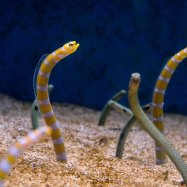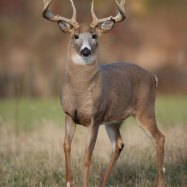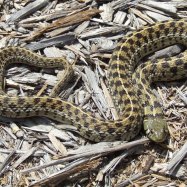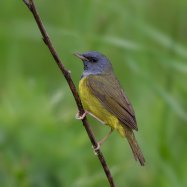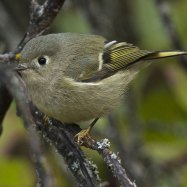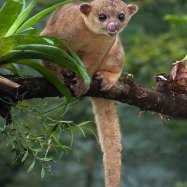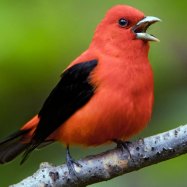
Green Mamba
Up to 2.5 meters (8 feet)
The Green Mamba is a highly venomous snake found in Kenya, Tanzania, Uganda, Mozambique, and South Africa. It belongs to the Elapidae family and can grow up to 2.5 meters in length. Its body is slender and elongated, making it one of the fastest and deadliest snakes in the world. Stay safe and avoid coming into contact with this beautiful, yet deadly creature.
Animal Details Summary:
Common Name: Green Mamba
Kingdom: Animalia
Habitat: Tropical rainforests, savannas, and coastal forests
The Lethal and Beautiful Green Mamba: An Untold Story of Africa's Elusive Snake
With its bright green skin and elusive nature, the Green Mamba is a fascinating creature that evokes both fear and awe. Found only in sub-Saharan Africa, this deadly snake has captured the attention of researchers and wildlife enthusiasts alike. Its scientific name, Dendroaspis angusticeps, literally means "tree snake with a narrow head," and it is no surprise that this creature has adapted to the dense forests of Africa. From its venomous bite to its unique hunting methods, the Green Mamba has many fascinating features that make it one of Africa's most iconic animals Green Mamba.Incredible Adaptations for Survival
As a top predator in its ecosystem, the Green Mamba has evolved some remarkable adaptations that have helped it survive in its harsh environment. Its bright green coloration camouflages it perfectly against the lush greenery of the tropical rainforests where it is most commonly found. This allows the snake to blend in seamlessly, making it almost impossible to spot by unsuspecting prey or predators.Another remarkable feature of this snake is its long and slender body, reaching up to 2.5 meters (8 feet) in length. Its slender and elongated shape enables it to maneuver effortlessly through the dense vegetation of its habitat. Coupled with its exceptional eyesight, the Green Mamba has become an agile and efficient hunter, making it one of the most feared predators in the African rainforests.
The Deadly Venom
One of the most distinct features of the Green Mamba is, without a doubt, its venomous bite. Its sharp and precise fangs are capable of injecting a lethal dose of neurotoxins into its prey Genet. The venom is so potent that it can kill a human within 20 minutes if left untreated. Fortunately, the Green Mamba is a shy and reclusive animal and will only attack in self-defense. In fact, it will choose to flee rather than engage in a confrontation with another animal or human.For many years, researchers have been intrigued by the composition and effects of the Green Mamba's venom. It is known to cause excessive bleeding and paralysis, leading to respiratory or cardiac failure in its victims. However, recent studies have shown that the venom of the Green Mamba has potentially lifesaving properties. Scientists have discovered that a component of its venom called "dendrotoxin" has neuroprotective effects that could potentially be used to treat Parkinson's and Alzheimer's disease.
Natural or Artificial Range?
The Green Mamba's natural habitat consists of the tropical rainforests, savannas, and coastal forests of sub-Saharan Africa. However, due to their striking coloration and popularity in the exotic pet trade, some Green Mambas have been introduced to other parts of the world. In some cases, these snakes have escaped or been released into the wild, creating artificial populations in countries such as the United States and Europe. While these snakes may seem like a desirable pet due to their beauty, their highly venomous nature and specific care requirements make them unsuitable for most people.Mystery Surrounding its Range
Despite its name and reputation, the Green Mamba's range is still shrouded in mystery. While it is known to be found in countries such as Kenya, Tanzania, Uganda, Mozambique, and South Africa, there have been sightings of this elusive snake in other African countries as well. The exact reason for this is not yet known, but it is believed that the Green Mamba may have been introduced to these areas by humans, much like its artificial populations in other parts of the world.Feeding Habits and Hunting Techniques
Like most snakes, the Green Mamba is a carnivore, and its diet primarily consists of small mammals, birds, and lizards. However, what sets it apart from other snakes is its unique hunting method. Unlike constrictors, which squeeze their prey to death, Green Mambas rely on their speed and agility to catch their prey. They are also known to be excellent climbers, often using their powerful grip and lightning-fast reflexes to catch birds in their nests.The Green Mamba's hunting technique is also closely linked to its prey's behavior. For example, if it senses that its prey is running away, it will quickly chase after it. If the prey becomes immobile due to fear, the snake will use its quick strikes and deadly venom to secure its meal. This hunting strategy has proven to be highly successful, making the Green Mamba one of the most feared predators in its habitat.
Conservation Status and Threats
Despite its lethal nature, the Green Mamba is facing several threats to its survival. The destruction of its natural habitat due to human activities such as deforestation, mining, and agriculture has significantly impacted its population. In addition, they are also hunted by humans for their skin, which is used to make luxury items such as belts and boots. The capture and illegal trade of these snakes for the exotic pet market also pose a significant threat to their survival.Fortunately, several organizations and conservation efforts are underway to protect the Green Mamba and its habitat. In some countries, laws have been put in place to regulate the capture and trade of these snakes, and educational programs have been implemented to raise awareness about their importance in their ecosystem. However, much more needs to be done to ensure the Green Mamba's continued survival in the wild.
Preserving the Mysterious and Beautiful Green Mamba
The Green Mamba is undoubtedly a remarkable and fascinating creature that holds a rich history in Africa's cultural and natural heritage. Its bright green skin and lethal venom have earned it a place in both fear and admiration in the hearts of many. While its elusive nature and lethal reputation may make it seem like a creature to be feared and avoided, it is important to remember the significant role it plays in maintaining balance in its ecosystem.Through ongoing conservation efforts, it is our hope that the Green Mamba and its lush rainforest habitat will be protected for future generations to admire and appreciate. The Green Mamba's story is a reminder of the delicate balance between humans and nature and the importance of coexisting with and protecting the world's most fascinating and elusive creatures.

Green Mamba
Animal Details Green Mamba - Scientific Name: Dendroaspis angusticeps
- Category: Animals G
- Scientific Name: Dendroaspis angusticeps
- Common Name: Green Mamba
- Kingdom: Animalia
- Phylum: Chordata
- Class: Reptilia
- Order: Squamata
- Family: Elapidae
- Habitat: Tropical rainforests, savannas, and coastal forests
- Feeding Method: Carnivorous
- Geographical Distribution: Sub-Saharan Africa
- Country of Origin: East Africa
- Location: Kenya, Tanzania, Uganda, Mozambique, and South Africa
- Animal Coloration: Bright green on the upper body, yellowish-green to pale green on the belly
- Body Shape: Slender and elongated
- Length: Up to 2.5 meters (8 feet)
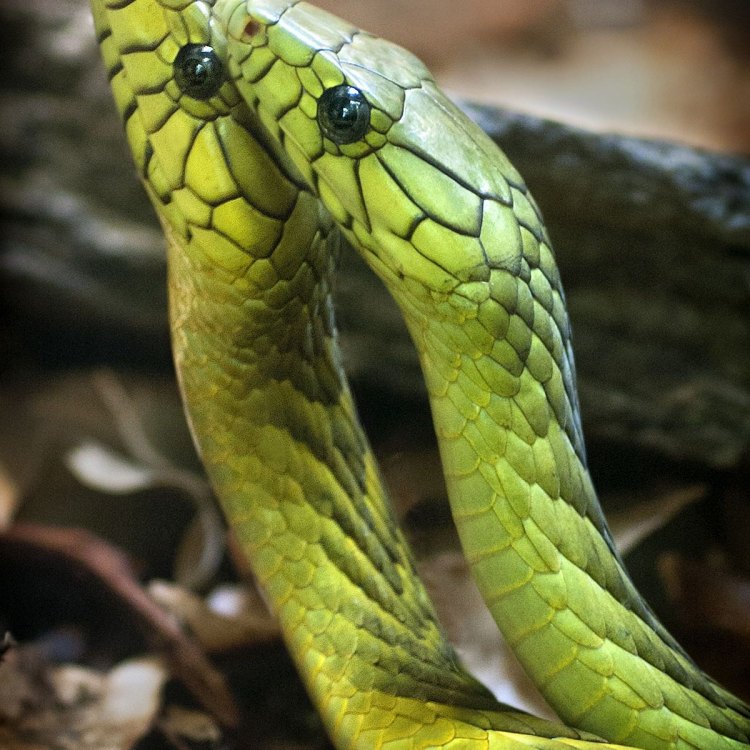
Green Mamba
- Adult Size: Large-sized snake
- Average Lifespan: 10-15 years
- Reproduction: Oviparous (lays eggs)
- Reproductive Behavior: Females lay a clutch of 10-20 eggs
- Sound or Call: No known significant vocalizations
- Migration Pattern: Non-migratory
- Social Groups: Solitary
- Behavior: Diurnal and arboreal snake
- Threats: Habitat loss and fragmentation, illegal pet trade, and persecution
- Conservation Status: Least Concern (IUCN)
- Impact on Ecosystem: Plays an important role in controlling rodent populations
- Human Use: Some individuals are kept as pets with proper permits and experience
- Distinctive Features: Long and slender body, bright green coloration, and black mouth lining
- Interesting Facts: 1. Green mambas are highly venomous snakes, known for their potent neurotoxin. 2. They are excellent climbers and spend most of their time in trees. 3. The venom of green mambas can cause rapid paralysis and can be lethal to humans. 4. Despite their name, green mambas can display various shades of green, from bright to pale. 5. Green mambas are fast-moving and agile, capable of striking from a distance.
- Predator: No known major predators
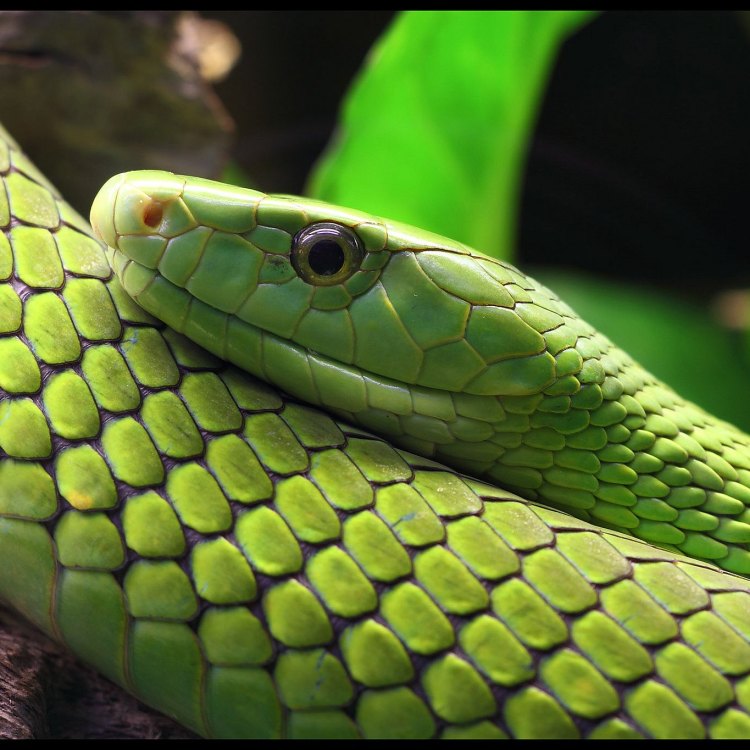
Dendroaspis angusticeps
The Mighty Green Mamba: An Iconic, Yet Misunderstood Snake
Revered by some and feared by others, the green mamba is a fascinating and often misunderstood species of snake. With its bright green coloration and potent venom, this snake has captured the imagination of many. But there is so much more to this creature than meets the eye. In this article, we will explore the unique features and behaviors of the green mamba, as well as its role in the ecosystem and its relationship with humans PeaceOfAnimals.Com.An Adult Size to Be Reckoned With
The green mamba, also known by its scientific name Dendroaspis angusticeps, is a large-sized snake, with an average adult length of 6-7 feet (1.8-2.1 meters). Its long and slender body is both an adaptation for climbing and a distinctive feature that sets it apart from other snakes. Despite its intimidating size, the green mamba is a relatively lightweight snake, with an average weight of 1.5-2 pounds (0.68-0.9 kilograms).A Relatively Short but Eventful Lifespan
In the wild, green mambas have an average lifespan of 10-15 years Golden Masked Owl. However, in captivity, they can live up to 20 years with proper care. This relatively short lifespan is due to a variety of factors, including habitat loss and fragmentation, illegal pet trade, and being hunted by humans for their venom. These threats have also led to the species being listed as Least Concern on the International Union for Conservation of Nature (IUCN) Red List.Oviparous with an Intriguing Reproductive Behavior
One of the most interesting aspects of the green mamba's reproductive cycle is that it is oviparous, meaning it lays eggs. Females usually lay a clutch of 10-20 eggs in a communal nest, often in hollow logs or other secluded areas. Once the eggs hatch, the baby green mambas are completely independent and must fend for themselves.The Sounds of Silence
Unlike many other reptiles, green mambas are not known for making significant vocalizations. They are usually silent creatures, relying on their coloration and agility to hunt and defend themselves.A Lone Wolf in the Animal Kingdom
Green mambas are solitary creatures, rarely seen in groups or pairs. They are most often found alone in their preferred habitat of tropical forests and woodlands. This solitary lifestyle may also be due to the fact that they are highly territorial creatures, with specific areas they mark and defend as their own.Diurnal and Arboreal: Understanding the Green Mamba's Behavior
Green mambas are diurnal, meaning they are most active during the day. They are also highly arboreal, spending most of their time high up in trees. Their slender bodies and excellent climbing abilities make it easy for them to maneuver through the treetops, where they hunt their prey, including birds, small mammals, and even other snakes.These snakes are also fast-moving and incredibly agile. They have been known to strike from a distance of up to 4 feet (1.2 meters), making them a formidable predator to their prey and a danger to humans who may come in contact with them.
The Perils of Survival
Despite their potent venom and solitary lifestyle, green mambas still face threats in their environment. Habitat loss and fragmentation due to human activities such as deforestation have reduced their natural habitats and food sources.Additionally, the illegal pet trade has also had a significant impact on the species. Many people are drawn to the beauty and rarity of green mambas, and as a result, they are often captured and sold illegally on the black market. This not only contributes to their declining population but also poses a danger to human safety as these highly venomous snakes may end up in the hands of inexperienced and untrained owners.
A Vital Player in the Ecosystem
Despite their intimidating reputation, green mambas play an essential role in their ecosystem. They are apex predators, meaning they are at the top of the food chain. As such, they help to control the populations of smaller animals, such as rodents, which can have a detrimental effect on the environment if left unchecked.Green mambas' presence in the ecosystem also helps to maintain a balance between prey and predators, which is crucial for a healthy and thriving ecosystem.
Human Interaction and the Green Mamba
Due to their striking appearance and intriguing behaviors, green mambas are often sought after as pets by reptile enthusiasts. However, due to their venomous nature, it is crucial that proper permits are obtained and that the owners have experience in caring for these animals.Unfortunately, the demand for green mambas as pets has also contributed to their declining numbers in the wild, as illegal capture and smuggling continue to threaten their population.
In some cultures, green mambas are revered and even worshipped, highlighting the complex relationship humans have with these snakes.
The Distinctive Features of the Green Mamba
What makes the green mamba stand out from other snakes? Apart from its venom and arboreal lifestyle, these snakes have some distinctive physical characteristics that make them easily recognizable.One of the most striking features is their bright green coloration, which gives them their name. However, it is essential to note that green mambas can display various shades of green, from pale to bright, depending on their environment and individual variation. They also have a black mouth lining, giving them a menacing appearance when they open their mouths, which they often do as a defense mechanism.
A Few Interesting Facts About the Green Mamba
1. Green mambas are highly venomous snakes, known for their potent neurotoxin.2. They are solitary and elusive creatures, making them difficult to study and observe in the wild.
3. Despite their name, green mambas can display various shades of green, from bright to pale.
4. The venom of green mambas can cause rapid paralysis and death in humans if left untreated.
5. Green mambas are incredibly fast and agile, capable of striking from a distance and moving quickly through their arboreal habitat.
In Conclusion
The green mamba is a fascinating and often misunderstood creature. With its bright green coloration, potent venom, and unique behaviors, it has captured the hearts and imaginations of many. However, it is essential to remember that these snakes are apex predators and must be respected and admired from a safe distance.As humans continue to encroach on their natural habitats, and illegal activities threaten their existence, it is crucial that we take the necessary steps to protect these magnificent creatures. They play an important role in the ecosystem and are a vital part of our planet's biodiversity. So let us appreciate the green mamba from a distance and do our part in ensuring their survival for generations to come.
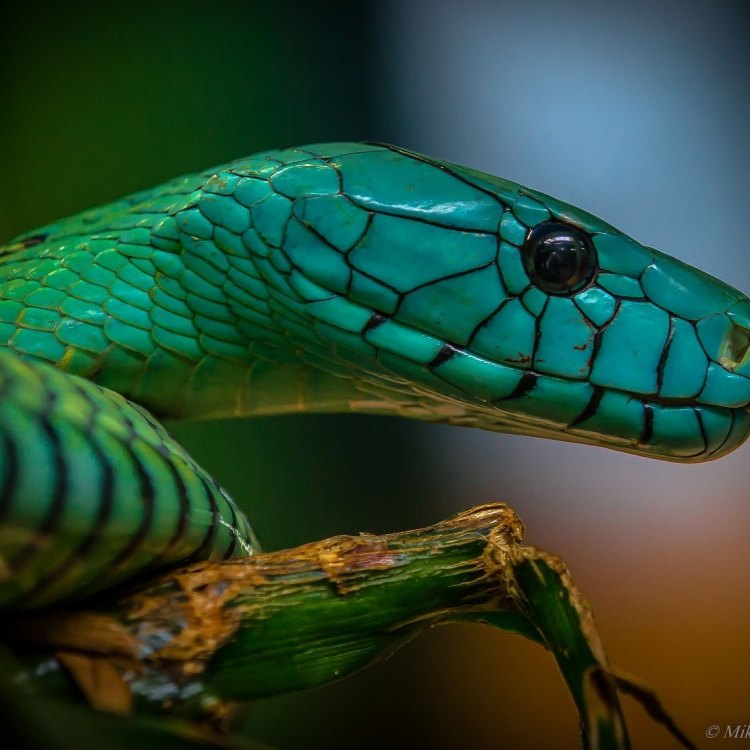
The Lethal and Beautiful Green Mamba: An Untold Story of Africa's Elusive Snake
Disclaimer: The content provided is for informational purposes only. We cannot guarantee the accuracy of the information on this page 100%. All information provided here may change without prior notice.

